Talwar Class Aircraft Carrier
India’s first effort at a purpose-built aircraft carrier, Urumi, was completed in mid-1927. The ship was intended to cooperate with the battle squadron, providing air defence, scouting, and a light strike capability. Whereas some other nations rushed ahead to build up their carrier force as quickly as possible, India instead filled out its battleline while gathering some operational experience with Urumi. During this time, the carrier was involved in several naval exercises and the Filipino Revolution. The Revolution saw her provide air defence to Indian naval forces, strike at Revolutionary light naval forces, and conduct ground attack and recce missions over land in support of the SATSUMA campaign to liberate Luzon in particular.
The Revolution demonstrated in particular a clear need to generate larger and more effective attacks against naval targets, and a more sustained ability to conduct operations supporting ground forces. Urumi’s small airgroup had constrained her in both regards; her limited flight deck space also made it difficult to spot a large attack force or operate torpedo-carrying aircraft. This confirmed the need to build a larger carrier than Urumi (which was important as there had been some consideration towards India building three additional small carriers). Talwar’s large size allows her to include two hangers plus a workshop forward of the upper hanger deck (in the drawing the area forward of the leading elevator). She is capable of taking on sixty aircraft, with an expectation of 24 fighters and 36 strike aircraft, including both Toofani scout-bombers and an as-yet unselected torpedo aircraft. Three elevators are provided, all offset from the centreline.
India expects the new carrier to operate primarily in the Indian Ocean, deploying elsewhere as requirements dictate. Two expected consequences - the low likelihood of a surface encounter, and the generally good weather - have driven the design of the ship's armor scheme and armament.
As Talwar can generally keep pace with most current heavy cruisers, any encounter with an enemy CA would likely take place at longer range - therefore, a thick armor deck is provided to protect against plunging 21 cm fire. The belt is thinner, and protects the ship's machinery and magazines from destroyer-calibre fire. There was little doubt that a torpedo bulkhead would be fitted to a ship of this size.
The hangers themselves are unprotected apart from internal fire screens (thick asbestos curtains) that can cut the hangers in three. The hangers are a light-weight structure above the armor deck, and can be opened to the outside via numerous shutters for dissapation of aircraft exhaust. In the minds of India's designers, this leaves the ship somewhat vulnerable to being "mission-killed", but allows for good performance in other areas of the design; besides which, the lightweight hangers should be amenable to rapid emergency repairs if the ship does survive the experience.
The armament is limited to 10.5 cm guns, sufficient to deal with enemy aircraft or lone destroyer-type ships that get in range. A large battery of light weapons is also included.
Talwar will be laid down in 1932; plans for a second unit have been deferred to 1934 as India evaluates the fate of the Cleito Treaty.
Thanks to Wes for the springsharp help; since the hull strength remains a bit higher than needed, the final design will likely add a bit of miscellaneous weight.
Thanks to Gavin for comments on hanger/elevator layout.
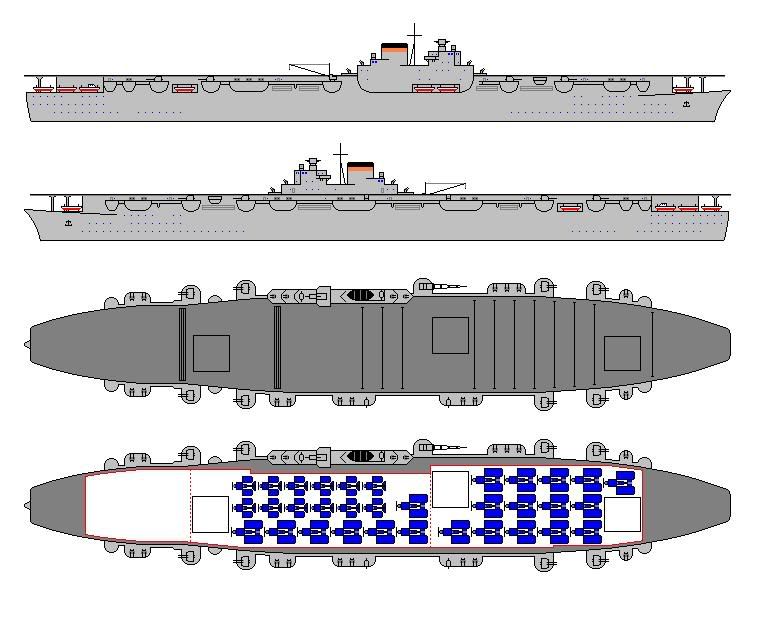 Edit: lower shutters are gone in this pic - see group pic if you're wondering what the difference is
Edit: lower shutters are gone in this pic - see group pic if you're wondering what the difference is
Talwar, Indian Aircraft Carrier laid down 1932
Edit-Edit: Springsharp improved with Wes tacking on a transom, adding some speed and a few other knick-knacks.
Displacement:
16,017 t light; 16,478 t standard; 18,657 t normal; 20,401 t full load
Dimensions: Length overall / water x beam x draught
695.37 ft / 684.38 ft x 81.69 ft x 23.36 ft (normal load)
211.95 m / 208.60 m x 24.90 m x 7.12 m
Armament:
16 - 4.13" / 105 mm guns (8x2 guns), 35.27lbs / 16.00kg shells, 1932 Model
Dual purpose guns in deck mounts with hoists
on centreline ends, evenly spread, all raised mounts - superfiring
28 - 1.38" / 35.0 mm guns (14x2 guns), 1.32lbs / 0.60kg shells, 1932 Model
Anti-aircraft guns in deck mounts
on side, all amidships, all raised mounts - superfiring
16 - 0.59" / 15.0 mm guns (8x2 guns), 0.10lbs / 0.05kg shells, 1932 Model
Machine guns in deck mounts
on side, evenly spread, all raised mounts
Weight of broadside 603 lbs / 273 kg
Shells per gun, main battery: 250
Armour:
- Belts: Width (max) Length (avg) Height (avg)
Main: 1.96" / 50 mm 467.00 ft / 142.34 m 9.85 ft / 3.00 m
Ends: Unarmoured
Main Belt covers 105 % of normal length
- Torpedo Bulkhead:
1.96" / 50 mm 467.00 ft / 142.34 m 9.85 ft / 3.00 m
- Gun armour: Face (max) Other gunhouse (avg) Barbette/hoist (max)
Main: 1.18" / 30 mm - -
2nd: 0.78" / 20 mm - -
3rd: 0.78" / 20 mm - -
- Armour deck: 3.14" / 80 mm, Conning tower: 2.35" / 60 mm
Machinery:
Oil fired boilers, steam turbines,
Geared drive, 4 shafts, 101,876 shp / 76,000 Kw = 31.87 kts
Range 20,000nm at 12.00 kts
Bunker at max displacement = 3,924 tons
Complement:
797 - 1,037
Cost:
£4.750 million / $18.998 million
Distribution of weights at normal displacement:
Armament: 75 tons, 0.4 %
Armour: 3,040 tons, 16.3 %
- Belts: 378 tons, 2.0 %
- Torpedo bulkhead: 334 tons, 1.8 %
- Armament: 42 tons, 0.2 %
- Armour Deck: 2,250 tons, 12.1 %
- Conning Tower: 36 tons, 0.2 %
Machinery: 3,007 tons, 16.1 %
Hull, fittings & equipment: 5,975 tons, 32.0 %
Fuel, ammunition & stores: 2,641 tons, 14.2 %
Miscellaneous weights: 3,920 tons, 21.0 %
-3,600 t: 60 aircraft
-25 t: command facilities
-175 t: seven crated spare aircraft
-120 t: weight reserve
Overall survivability and seakeeping ability:
Survivability (Non-critical penetrating hits needed to sink ship):
27,770 lbs / 12,596 Kg = 786.2 x 4.1 " / 105 mm shells or 4.0 torpedoes
Stability (Unstable if below 1.00): 1.11
Metacentric height 4.5 ft / 1.4 m
Roll period: 16.1 seconds
Steadiness - As gun platform (Average = 50 %): 70 %
- Recoil effect (Restricted arc if above 1.00): 0.07
Seaboat quality (Average = 1.00): 1.20
Hull form characteristics:
Hull has a flush deck
and transom stern
Block coefficient: 0.500
Length to Beam Ratio: 8.38 : 1
'Natural speed' for length: 30.28 kts
Power going to wave formation at top speed: 54 %
Trim (Max stability = 0, Max steadiness = 100): 58
Bow angle (Positive = bow angles forward): 20.00 degrees
Stern overhang: 0.00 ft / 0.00 m
Freeboard (% = measuring location as a percentage of overall length):
- Stem: 30.18 ft / 9.20 m
- Forecastle (20 %): 20.77 ft / 6.33 m
- Mid (50 %): 20.77 ft / 6.33 m
- Quarterdeck (15 %): 20.77 ft / 6.33 m
- Stern: 20.77 ft / 6.33 m
- Average freeboard: 21.52 ft / 6.56 m
Ship space, strength and comments:
Space - Hull below water (magazines/engines, low = better): 104.8 %
- Above water (accommodation/working, high = better): 192.3 %
Waterplane Area: 38,738 Square feet or 3,599 Square metres
Displacement factor (Displacement / loading): 137 %
Structure weight / hull surface area: 109 lbs/sq ft or 530 Kg/sq metre
Hull strength (Relative):
- Cross-sectional: 0.99
- Longitudinal: 1.15
- Overall: 1.00
Hull space for machinery, storage, compartmentation is adequate
Room for accommodation and workspaces is excellent
Ship has slow, easy roll, a good, steady gun platform

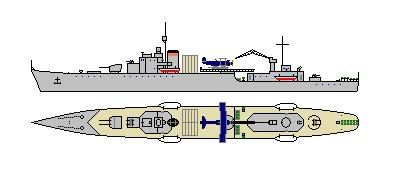
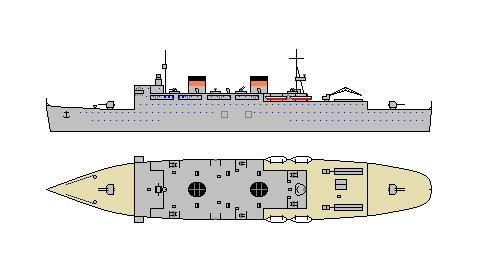
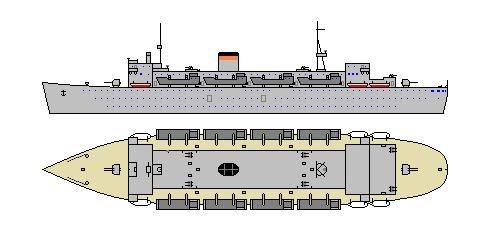
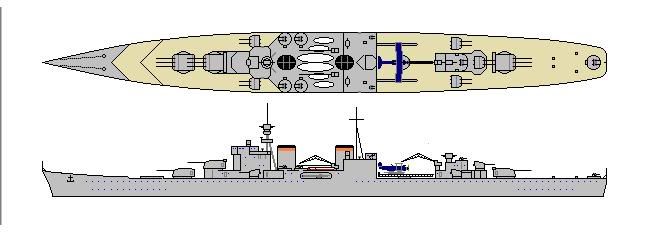

 Are those shutters for the lower hangar? You definitely don't want them. Too close to the seaway. I'd also expect them to be a bit higher. What height are the hangars? 4.5m or so?
Are those shutters for the lower hangar? You definitely don't want them. Too close to the seaway. I'd also expect them to be a bit higher. What height are the hangars? 4.5m or so? Quoted
Originally posted by The Rock Doctor